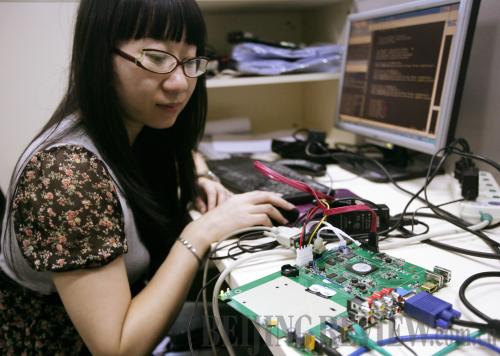|
 |
|
SOME ASSEMBLY REQUIRED: A researcher works on a component for a high-definition media Internet download player at a company in Z-Park (WANG XIANG) |
China's first hi-tech science park just got an upgrade. Zhongguancun Science Park (Z-Park) in northwest Beijing will serve as the national innovation model park for other similar science hubs across the country—and it's currently the only park model approved by the Chinese Government.
The science park recently unveiled the Action Plan on Establishing the Zhongguancun National Innovation Model Park (2010-12), which will help China achieve its goal of becoming an innovative country. According to the plan, by 2012, Z-Park will have a primary system framework favorable to innovation, and research and development expenditures will have increased by 15 percent, compared to 2009 figures. The proportion of R&D expenditures in the park's total income will surpass 4 percent. Z-Park will continuously produce world-recognized innovations, and the number of invention patents by companies in the park will increase by 60 percent, compared to 2009. Corporate innovation capabilities will be improved, as will the international competitiveness of strategic emerging industries.
Yang Jianhua, Deputy Director of the Management Committee of Z-Park, said the development outlines for Z-Park, extending as far as 2020, will be jointly made by several ministries and commissions of the Central Government and will be released soon. This is the first time that several ministries and commissions have come together to create an outline for a science park.
Before it became Z-Park, the Zhongguancun area was called "Electronics Avenue" due to the large number of information technology and electronics-related businesses in its vicinity. In May 1988, the State Council officially recognized the Zhongguancun area as the Beijing New Tech Industrial Development Trial Zone, which was later changed to Z-Park. The science and technology center, as China's first hi-tech park, has also become a trial zone for economic, scientific and educational reform. In 2006, the State Council approved a new plan for Z-Park to cover a total area of 232 square km.
Now, nearly 20,000 hi-tech companies, such as Lenovo and Founder; 39 universities, including Peking University and Tsinghua University; as well as 140 research institutions, such as the Chinese Academy of Sciences (CAS), are located in Z-Park's boundaries. Within the park, there are 57 national-level labs, 26 national engineering research centers, 29 national engineering and technology research centers, 17 university-affiliated science parks and 29 start-up parks for overseas returns. The number of returned students that start their business in Z-Park accounts for one fourth of the country's total number of returned students. Moreover, in Z-Park there are more than 30 new industrial associations established, managed and operated by companies in different fields.
The number of start-up companies and investment in Z-Park every year accounts for about one third of the national total, so does their combined investment volume. And every year, an average of 10 companies from the park are listed on the stock market. A large number of intellectual property right (IPR) achievements have also been made in Z-Park.
In 2009, the aggregate revenues generated by the companies in Z-Park reached 1.2 trillion yuan ($176.99 billion), a year-on-year increase of 20 percent. Yang said the science park focuses on development within strategic emerging industries involving new energies, energy conservation and environment protection, electric vehicles, pharmaceuticals and information technologies.
Policy testers
"To improve the innovation capabilities of corporations, we have experimented with a few new policies," Yang said.
During Z-Park's first stock ownership incentive program, universities, research institutions and state-owned hi-tech enterprises within the park granted stocks or rights to dividends to their research personnel as a means of encouragement.
Financing policies were also implemented to support angel investment, venture capital and equity investment to cover the costs of the technology innovation process. Z-Park also encourages new industrial organizations and private enterprises within the park to participate in key national-level projects.
The park also supports 200 companies involved in the information technology, biological engineering and new pharmacies, energy and environment protection, new materials, and aviation and space industries.
Also, by 2012, Z-Park will realize industrial production of at least 20 key technologies. Currently, 10 projects have been fixed, including a chip project by the CAS Institute of Computing Technology, the nano meter material green printing technology by the CAS Institute of Chemistry, and an anti-cancer pharmacy project by Protgen Ltd.
Z-Park will also implement demonstration projects for key technologies, organizing more than 20 products developed in the park to be put into production. Most of these technologies will help tackle problems in urban emergency measures, rail transportation, garbage and sewage disposal, as well as health care, and all products and technologies have independent IPRs, Yang said.
|
